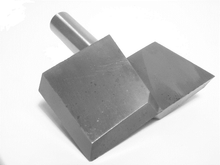I had planned to have a cutter dia of slightly over 3/4". Using a form tool, the beads would made before the 3 wings were cut with the mill and dividing head. The only filing would be the slight relief behind the cutting edge. The balance of the cutter is my main concern.
If it works, well you will get pictures in a couple of weeks. If it doesn't, well.........
This should work ok.
The smaller the radius, the larger the clearance angles, is partly why i prefer a bit more diameter.
Make it out of O-1 drill rod and you can harden it in a bucket of oil, and temper it in the kitchen oven when the wife is away. Don't harden a tool and run it without tempering, even if the temper is such that it barely draws the metal. It still makes the steel tougher and removes stresses that could cause the un-tempered tool to break.
Since this is a one-time use tool, you could create side clearance in the profile, by shaping the tooth edge from the back, with a taper pin or repairman's reamer. OTOH, for an original antique, no doubt the form was hand filed. Turn your round with the beads, cut the flutes on the front to create neutral to very barely pos rake, then cut the backs to thin the wings for less mass, and so the filing for relief is easier. Don't file quite to the lips.
Actually, if i was making it, i would probably cut the flutes, and then cut the profile with a 1/4" end mill, from the back. on a somewhat "extreme" clearance angle. Since the profile is round, this will give enough radial and axial clearance; though the profile will minutely become and oval, rather than perfect round. If you can even see it, this can be adjusted by honing lightly, after the tool is hardened. OTOH, we both probably know that by the time a tool is complete, a 1/4" EM might have completed a slightly larger than 1/4" profile, so you have to figure that if the original is smaller. I have enough re-sharps here to sort for (or make) one undersize.
Harden & temper the tool. then use hard india medium round, cone, or pear shape slips to hone to the edge from the back, making sure to maintain the clearance and not over-dub the edge.
It will cut fine, and if you hone it every time before use, it will cut quire a bit of antique feature mold before you pass on and someone at your estate sale has to figure out what that old genius toolmaker made it for.

If you have trouble making the first one, an easier route is to just make a cutter for one flute at a time and keep adjusting your router table, using a couple pieces of scrap to compare location/height of succeeding grooves.
smt




